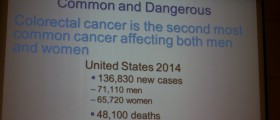
Definition of Colorectal Cancer
Colorectal cancer is a malignant tumor affecting the colon or its terminal part, the rectum. This malignant disease is also known under the name bowel cancer. Colorectal cancer does not include anal cancer which actually originates from different tissues and is a separate malignant disease.
Colorectal cancer originates from the cells of the lining of the colon or the rectum. Once formed, the tumor gradually grows, infiltrating all the layers and finally causing perforation of the bowel, if left untreated or not diagnosed on time. In the majority of cases colorectal cancer develops out of a precancerous lesions of the gastrointestinal tract known as polyps or adenomas. Such growths are initially benign but some of them may undergo malignant transformation eventually progressing into malignant tumors.
As for early diagnosis it is possible to be established in individuals with a family history or colon cancer and those already confirmed with polyps or adenoma who undergo regular screening and check-ups as well as routine colonoscopy. Colonoscopy is an excellent means of diagnosing and early treatment for colorectal cancers. In people who are at higher risk for colorectal cancer, this diagnostic (and sometimes treatment options) is performed on regular basis.
Signs, Symptoms and Diagnosis
Basically symptoms and signs of colorectal cancer depend on several factors including the size of the tumor, its location, the absence or the presence of bowel obstruction and spread of the tumor (metastasis).
Local symptoms associated with this malignant disease are reported more in individuals in whom the tumor is located closer to the anus. They typically complain about a change in bowel movement (constipation and/or diarrhea), rectal tenesmus (a sensation that defecation has not been completely accomplished). Lower gastrointestinal bleeding (the presence of fresh blood in the stool, stool sprinkled with blood etc.) is also characteristic for colorectal cancer although it may also occur in other illnesses such as hemorrhoids. The increased presence of mucus sometimes occurs as well. As for tumors that are located in the upper parts of the colon, they usually cause loss of blood which reflects in melena and black stool with tarry appearance.
Bowel obstruction develops as a consequence of blockage of the colon with the abnormally large tumor. Symptoms and signs of bowel obstruction are constipation and lacks of gas, abdominal pain/cramping, abdominal distension, nausea and vomiting. Tumors that have penetrate all the layers of the large intestine cause perforation and associated peritonitis while compression of the ureters may easily result in hydronephrosis. Invasion of the bladder is accompanied by the presence of blood in urine.
In advanced stages, a doctor is able to palpate the tumor mass in a patient's belly.
Bleeding is a common problem for patients suffering from colon cancer. Even when the tumor is rather small in size it may bleed persistently, eventually triggering anemia. Such patients are additionally pale, experience fatigue and heart issues (e.g. palpitations). Furthermore, colorectal cancer is commonly associated with loss of appetite and drastic weight loss.
Finally, certain number of patients ends up with thrombosis (usually deep vein thrombosis) or paraneoplastic syndrome (a set of different symptoms and signs that develop due to the very presence of the tumor in the body). Diagnosis of colorectal cancer is established with the assistance of evaluation of the patient's medical history physical examination, digital rectal exam, and thanks to additional test and exams like fecal occult blood test and blood tests. Colonoscopy is always performed. It allows the insight into intraluminal tumors which are easily biopted during the procedure. Tissue samples are then pathohistologically examined. Extraluminal tumors can be confirmed with CT scan or MRI of the abdomen. These imaging methods also confirm bowel obstruction if it is present. There are specific tumors markers that are increased in such patients and these are also routinely checked. Recurrent colorectal cancer can be confirmed with PET. Genetic counseling and testing is reserved for families with a hereditary form of the disease. These individuals as well people at higher risk are due to undergo regular screening and routine colonoscopy.
Staging of Colorectal Cancer
There are several staging approaches when it comes to colorectal cancer. Most of these approaches take into consideration the amount of tumor penetration which is of major importance for the treatment and outcome. The extend of local invasion, the degree of lymph node involvement as well as the presence or the absence of further tumor spread (metastases) are all considered when staging the disease.
Even though the most common staging form known as TNM (tumor/nodes/metastases) classification is optional, doctors most of the time opt for Dukes system and Astler-Coller classification. Dukes system has 4 stages classified as A,B,C and D, stage A being the initial while stage D being the terminal stage of the disease. Astler-Coller classification is similar to Dukes system and has the following stages: A, B1, B2, C1, C2 and D. Once again stage A is initial stage while stage D points to the advanced colorectal cancer. Histological grade of the tumor is of great prognostic importance as well.
Relevant Data
Colorectal cancer that remains within the wall of the large bowel is curable with surgery and such patients have 90% chances to survive at least 5 years after being diagnosed. Cancer that has spread to regional lymph nodes is more aggressive and the outcome is not so good, with frequent relapses and the increased risk for soon occurrence of distant metastases. These patients have 48% chances to survive 5 years after being diagnosed. Finally, only 7% of those with advanced stage of the disease and identified distant metastases may survive 5 years.
The worrying fact is that colorectal cancer represents the third most commonly diagnosed malignant tumor in the world. It affects more people in developed countries which clearly correlates with the dietary regimes that are frequently followed in these countries.

















Your thoughts on this
Loading...